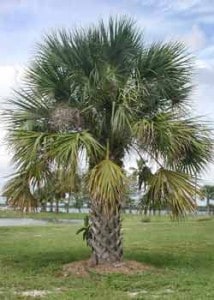
Palms belong to the monocot family, along with grasses, orchids, and bromeliads. Palms are not capable of secondary growth and thus, do not have annual growth rings. Palms emerge from the ground at their lifelong diameter, completing their thickening growth before elongating. By contrast, a tree continually increases in diameter as it ages, which can be seen in the growth rings.
Palms have vascular bundles that transfer water and nutrients to the ‘palm heart’. These bundles have been compared to steel-reinforced concrete, the ‘steel’ inside the concrete being the vascular bundle. There are a fixed amount of bundles that must last the life of the palm. The palm heart, if killed, ends the life of the entire palm.
Roots: All palms have roots that develop from the stem and emerge from there at maximum thickness. They are also incapable of secondary growth. They do have three distinct levels of branching, however. The smallest roots absorb water and nutrients, but are not considered root hairs because palms do not produce them. Palm roots do have the capacity for significant lateral growth. Roots have been found over 100 feet from the trunk.
Stems: Palm stems vary widely. They can be very thin, as in the Rhapis or very thick like the Canary Island Date. Some keep the leaf bases intact, often referred to as booted. Others develop a slick trunk as the boots shed naturally. Palm trunks can be brown, grey or green, fibrous, spiny or bumpy. Leaf base scars can develop a distinctive pattern on the trunk.
Leaves: Palm leaves are the largest organs in the plant kingdom. There are three main parts to a leaf: the blade, petiole (stem), and leaf base. The blades fall into three main categories: palmate (fan palms), pinnate/bipinnate (feather), or entire leaves.
Flowers: Palm flowers are typically very small but bloom on a flower stalk or inflorescence in large numbers and are collectively showy. Most inflorescence emerges among the leaves.
Fruit: The palm fruit (and seeds) are usually larger and more noticeable than the flowers. The largest seed of any plant known on earth is the double coconut. Most fruits contain only one seed and have a fleshy or fibrous outer wall that is brightly colored.
Planting: When transplanting palms it is usually advisable to tie the crown up or remove it completely when the species you are transplanting must regenerate roots from the trunk. Cabbage palms are typically ‘hurricane cut’, or all the leaves are removed, when they are transplanted. Root balls should be, on average, a one foot radius from the trunk and one foot deep. In our heavy clay soils, bracing is not required when planting palms. In sandy soils they should be braced for 6-8 months.
Thank you for reviewing this information. Schneider Tree Care is committed to preserving and enhancing the quality of your property through tree care education and services. We employ professionally trained and certified arborists who are available to meet with you for a consultation at no charge.
If you have any questions or need additional information regarding the health of your trees, please
contact us.
 Palms belong to the monocot family, along with grasses, orchids, and bromeliads. Palms are not capable of secondary growth and thus, do not have annual growth rings. Palms emerge from the ground at their lifelong diameter, completing their thickening growth before elongating. By contrast, a tree continually increases in diameter as it ages, which can be seen in the growth rings.
Palms have vascular bundles that transfer water and nutrients to the ‘palm heart’. These bundles have been compared to steel-reinforced concrete, the ‘steel’ inside the concrete being the vascular bundle. There are a fixed amount of bundles that must last the life of the palm. The palm heart, if killed, ends the life of the entire palm.
Roots: All palms have roots that develop from the stem and emerge from there at maximum thickness. They are also incapable of secondary growth. They do have three distinct levels of branching, however. The smallest roots absorb water and nutrients, but are not considered root hairs because palms do not produce them. Palm roots do have the capacity for significant lateral growth. Roots have been found over 100 feet from the trunk.
Stems: Palm stems vary widely. They can be very thin, as in the Rhapis or very thick like the Canary Island Date. Some keep the leaf bases intact, often referred to as booted. Others develop a slick trunk as the boots shed naturally. Palm trunks can be brown, grey or green, fibrous, spiny or bumpy. Leaf base scars can develop a distinctive pattern on the trunk.
Leaves: Palm leaves are the largest organs in the plant kingdom. There are three main parts to a leaf: the blade, petiole (stem), and leaf base. The blades fall into three main categories: palmate (fan palms), pinnate/bipinnate (feather), or entire leaves.
Flowers: Palm flowers are typically very small but bloom on a flower stalk or inflorescence in large numbers and are collectively showy. Most inflorescence emerges among the leaves.
Fruit: The palm fruit (and seeds) are usually larger and more noticeable than the flowers. The largest seed of any plant known on earth is the double coconut. Most fruits contain only one seed and have a fleshy or fibrous outer wall that is brightly colored.
Planting: When transplanting palms it is usually advisable to tie the crown up or remove it completely when the species you are transplanting must regenerate roots from the trunk. Cabbage palms are typically ‘hurricane cut’, or all the leaves are removed, when they are transplanted. Root balls should be, on average, a one foot radius from the trunk and one foot deep. In our heavy clay soils, bracing is not required when planting palms. In sandy soils they should be braced for 6-8 months.
Thank you for reviewing this information. Schneider Tree Care is committed to preserving and enhancing the quality of your property through tree care education and services. We employ professionally trained and certified arborists who are available to meet with you for a consultation at no charge.
If you have any questions or need additional information regarding the health of your trees, please contact us.
Palms belong to the monocot family, along with grasses, orchids, and bromeliads. Palms are not capable of secondary growth and thus, do not have annual growth rings. Palms emerge from the ground at their lifelong diameter, completing their thickening growth before elongating. By contrast, a tree continually increases in diameter as it ages, which can be seen in the growth rings.
Palms have vascular bundles that transfer water and nutrients to the ‘palm heart’. These bundles have been compared to steel-reinforced concrete, the ‘steel’ inside the concrete being the vascular bundle. There are a fixed amount of bundles that must last the life of the palm. The palm heart, if killed, ends the life of the entire palm.
Roots: All palms have roots that develop from the stem and emerge from there at maximum thickness. They are also incapable of secondary growth. They do have three distinct levels of branching, however. The smallest roots absorb water and nutrients, but are not considered root hairs because palms do not produce them. Palm roots do have the capacity for significant lateral growth. Roots have been found over 100 feet from the trunk.
Stems: Palm stems vary widely. They can be very thin, as in the Rhapis or very thick like the Canary Island Date. Some keep the leaf bases intact, often referred to as booted. Others develop a slick trunk as the boots shed naturally. Palm trunks can be brown, grey or green, fibrous, spiny or bumpy. Leaf base scars can develop a distinctive pattern on the trunk.
Leaves: Palm leaves are the largest organs in the plant kingdom. There are three main parts to a leaf: the blade, petiole (stem), and leaf base. The blades fall into three main categories: palmate (fan palms), pinnate/bipinnate (feather), or entire leaves.
Flowers: Palm flowers are typically very small but bloom on a flower stalk or inflorescence in large numbers and are collectively showy. Most inflorescence emerges among the leaves.
Fruit: The palm fruit (and seeds) are usually larger and more noticeable than the flowers. The largest seed of any plant known on earth is the double coconut. Most fruits contain only one seed and have a fleshy or fibrous outer wall that is brightly colored.
Planting: When transplanting palms it is usually advisable to tie the crown up or remove it completely when the species you are transplanting must regenerate roots from the trunk. Cabbage palms are typically ‘hurricane cut’, or all the leaves are removed, when they are transplanted. Root balls should be, on average, a one foot radius from the trunk and one foot deep. In our heavy clay soils, bracing is not required when planting palms. In sandy soils they should be braced for 6-8 months.
Thank you for reviewing this information. Schneider Tree Care is committed to preserving and enhancing the quality of your property through tree care education and services. We employ professionally trained and certified arborists who are available to meet with you for a consultation at no charge.
If you have any questions or need additional information regarding the health of your trees, please contact us. 




